国际商务谈判教案讲义chapter
- 格式:doc
- 大小:32.50 KB
- 文档页数:3
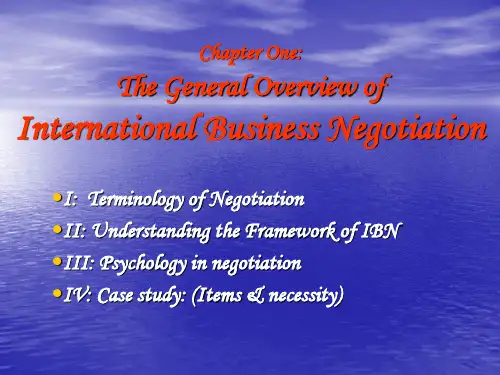
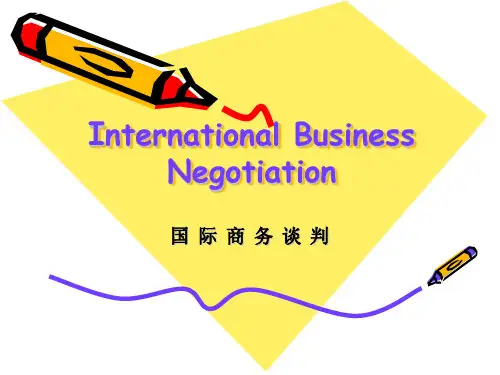
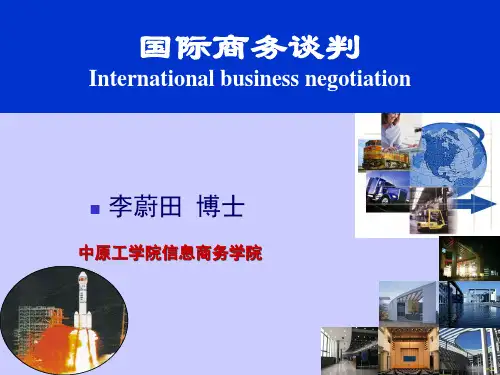
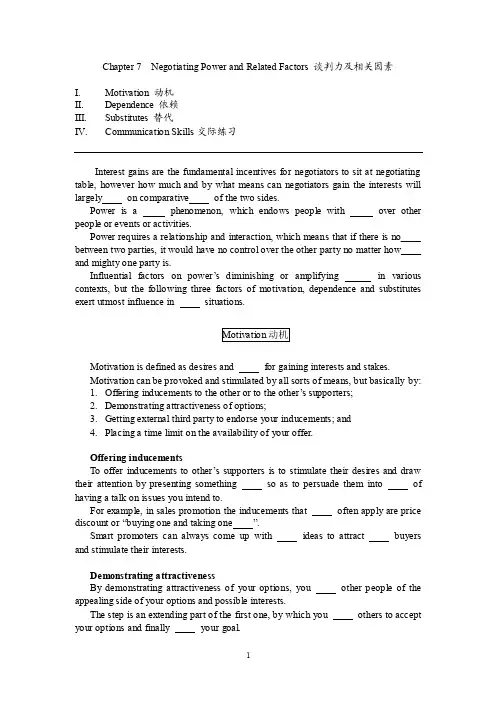
Chapter 7 Negotiating Power and Related Factors 谈判力及相关因素I.Motivation 动机II.Dependence 依赖III.Substitutes 替代munication Skills交际练习Interest gains are the fundamental incentives for negotiators to sit at negotiating table, however how much and by what means can negotiators gain the interests will largely on comparative of the two sides.Power is a phenomenon, which endows people with over other people or events or activities.Power requires a relationship and interaction, which means that if there is no____ between two parties, it would have no control over the other party no matter how____ and mighty one party is.Influential factors on power’s diminishing or amplifying in various contexts, but the following three factors of motivation, dependence and substitutes exert utmost influence in situations.Motivation is defined as desires and for gaining interests and stakes.Motivation can be provoked and stimulated by all sorts of means, but basically by:1.Offering inducements to the other or to the other’s supporters;2.Demonstrating attractiveness of options;3.Getting external third party to endorse your inducements; and4.Placing a time limit on the availability of your offer.Offering inducementsTo offer inducements to other’s supporters is to stimulate their desires and draw their attention by presenting something so as to persuade them into of having a talk on issues you intend to.For example, in sales promotion the inducements that often apply are price discount or “buying one and taking one ”.Smart promoters can always come up with ideas to attract buyers and stimulate their interests.Demonstrating attractivenessBy demonstrating attractiveness of your options, you other people of the appealing side of your options and possible interests.The step is an extending part of the first one, by which you others to accept your options and finally your goal.“The selling points” is an expression of demonstrating attractiveness.Getting external third parties’ backWhen there are external third parties backing your inducements, you your credibility through examples to cause others to .People will their friends, colleagues, persons they are familiar with and even if they belong to the same group.A repeatedly used persuasive method by advertisements is consumers acting as examples to others or a patient telling you how he has from the ailment after taking certain medicine.Public , famous singers and actors also play a part in this persuasive game.Placing a time limitLastly, it is important to let people know that those offers are not always there, i.e., they have their lines, which is the deadline for gaining. Otherwise common feeling of wait-and-see among people will make your efforts in nothing.A relatively time limit works better than a one because people make decisions often in a rush.Longer time limit sometimes retards people’s action and diminishes their .Conclusion:A party’s power is increasing with of its motivation.Dependence is a constant and regular need that someone has for something in order to be able to survive or operate properly.In negotiation, dependence is the need one party has from its for realizing its goals.If a party can successfully the other’s dependence on itself and meanwhile____ its own dependence on the other, then the party’s power will be strengthened significantly.The most effective and often explored methods to this end are:1.Reducing, delaying or withholding services or resources the other party____to attain;2.Blocking the other party’s to work on their own;3.Convincing the other party’s to block the other party’s operation’4.Convincing the other party of the hopelessness of trying to on theirown.Reducing, delaying or withholding services or resourcesThe other party’s dependence on you will if it is resourceful and endorsed by sufficient services that it needs.Being cut off the provision and sustenance, the other party will be forced to____to you for help, thus its dependence on you .In production, when the sources of material supply are limited, the producer’s power will be in negotiation with the unless he can find some replacement.Blocking the other party’s ability to work on their ownWhen a person, a company or a nation is self-sufficient and capable of working on their own, it is of any pressure and threat form the others.However in today’s world there is no absolute economic .Generally speaking, when a country exports heavily to another country, we say the exporting country depends on the importing country for sustainable production employment and development with the that the exported commodities are nonrenewable such as oil.When inflow of foreign investment into China is accumulating at a high speed, the foreign investors’ dependence on China simultaneously.Isolating the other partyIt is difficult to increase the other party’s dependence it is deprived of supporters.In military campaign against terrorism in Afghanistan after New Y ork and Washington were attacked on September 11, 2001, US government no efforts in winning supports from its aliens, compassionate countries, its foes, as well as the traditional friends of Afghanistan like Pakistan.By this way, American successfully Ben Ladan and Taliban and destroyed the terrorist bases in Afghanistan.Convincing the other party to give upHaving split the supporters of the other party, it is time for you to convince the other party that it is continuing with its own since it is fighting in .Conclusion:A party’s negotiating power is with increasing of its dependence on the other party.Substitutes are alternatives one party can explore to reduce its on the other party.A party’s chances of gaining substitutes increase in the context that:1. One party has alternatives which allow operating the other party;2. One party is able to absorb the escalating cost of conflict;3. One party can continue despite the other party’s discouraging effects on its supporters;4. One party has ability to use expert counsel, persuasion, communication and legal, historical or moral precedents to gain to alternatives.Conclusion:One party’s negotiating power is strengthened when there are more available for preference.Negotiating power analysis is crucial to negotiation strategy decision and to a degree of assertiveness and cooperativeness in negotiation.A party standing in stronger position tends to apply tactics in negotiation for the purpose of placing on the counterpart to make concession.Such tactics often explored include:1.Time pressure----setting a for acceptance of conditions putforward, otherwise punishment of either or military actions wouldbe taken;2.Appearing firm----keeping high assertiveness in expectation ofother’s ;3.Ridiculing other’s position----making others give up their stance by____or showing disrespect to their position;4.Building prominence of your offer----augmenting significance of youroffer to the other to make yielding; and5.Threatening the relationship----warning possibility of relationshipbreaking down, a pressure on the other who has a high degree of ____onyou.Conclusion:Consequences of power tactics depend on application of heavy or light tactics. The former often evokes counter power. The latter, light tactics often lead negotiation to collaboration and relation building, which may necessary compromises.1. To make a polite suggestion, use the word should. Make the sentence as a polite suggestion.1) We ought to negotiate the problem.2) He’d better know her n ame.3) I’d better finish the report.4) Mrs. Billings ought to call right now.5) The manager ought to write an agenda.2. Use opposite adjectives to soften the following remarks1)This is a very unproductive meeting.2)This is the worst food I’ve ever tast ed.3)Don’t be so late tomorrow.4)Y ou really are very inexperienced.5)Y our quotation is much too expensive.6)Y our financial position is insecure.3. How do you see yourself?Use the questionnaire below to find out. Tick one or the other of the following state ments. If you can’t decide, tick neither.a. I start the day with a list of things to do.b. I start the day by having a chat with my colleagues.a. I don’t let personal feelings influence decisions.b. When making decisions, I look at the human angle first.a. If colleagues do a good job, it does not matter if I like them or not.b. It’s important for me to like the people I work with.a. I see meetings only as a means to get business done.b. I see meetings partly as an opportunity to develop team relationships.a. At the end of the day, I am frustrated if I haven’t achieved what I set out to.b. At the end of the day, I feel “low” if I haven’t got on with my colleagues. Scoring: Score 2 points for every a sentence you ticked.Score 0 points for every b sentence you ticked.Score 1 point for every time you ticked neither.4. Read the following statements and tell which is True or false?1). We must always aspire high in our strategic thinking.2). For a quick deal, we don’t need to hav e very precise targets, and very clear views about the extent to which we could compromise.3). The first thing you need to do in dealing with a difficult person is to control thatperson’s behavior but not to control your own.4). It is imperative that good negotiators know how to both manage and express angerappropriately.5).Conflict can provide us with new information about a situation.6). In the middle of a negotiation it is sometimes ineffective to substitute a new team leader.7). In the strategy of reversal, you act in opposition to what may be considered to be the popular trend or goal.8). It is desirable that each negotiator should negotiate in a style foreign to him which reflects his strengths.9). Core values are powerful because they generate feelings, thoughts and behavior.They are deeply held values that govern how you behave across a great many situations.10) Effective negotiators accept that they are human----not perfect----and they turntheir mistakes into learning opportunities. Therefore, they have a longer recoverytime before returning to full effectiveness.5. Put the following situational dialogue into English.(支付方式Terms of payment) (two days later)Please see chapter 6。

教案•课程介绍与目标•国际商务谈判基础知识•前期准备工作与策略制定•实战技巧:如何进行有效沟通与交流目•僵局处理及让步策略运用•合同签订后跟进工作注意事项录课程介绍与目标01CATALOGUE全球化背景下的国际商务谈判重要性日益凸显培养学生跨文化沟通能力与商务谈判技巧,提升国际竞争力应对复杂多变的国际市场环境,为企业创造商业价值课程背景及意义掌握国际商务谈判的基本理论、原则和策略培养学生分析案例、解决实际问题的能力锻炼学生团队协作、沟通技巧和心理素质要求学生具备跨文化敏感性和商业伦理意识01020304教学目标与要求《国际商务沟通》,XXX 著,XXX 出版社参考资料教材:《国际商务谈判》(第X 版),XXX 著,XXX 出版社《跨文化商务谈判》,XXX著,XXX 出版社相关学术期刊、网站及案例库教材与参考资料0103020405国际商务谈判基础知识02CATALOGUE商务谈判概念及特点商务谈判定义商务谈判是买卖双方为了促成交易而进行的活动,或是为了解决买卖双方的争端,并取得各自的经济利益的一种方法和手段。
商务谈判特点以经济利益为目的、以价格谈判为核心、注重合同条款的严密性与准确性、谈判环境的多样性与复杂性、谈判条件的原则性与可伸缩性。
国际商务谈判原则与技巧国际商务谈判原则客观真诚、平等互惠、求同存异、讲究信用、据理力争与事先预防相结合等。
国际商务谈判技巧开局技巧(协商式开局、坦诚式开局、慎重式开局、进攻式开局)、报价技巧(高报价法、鱼饵报价法、中途变价法)、磋商技巧(故布疑阵、竞争对比、最后通牒等)、成交技巧(条件法、激将法、步步为营法、选择成交法等)。
跨文化沟通在商务谈判中应用跨文化沟通定义01跨文化沟通是指不同文化背景的人之间发生的沟通行为。
跨文化沟通在商务谈判中的重要性02避免因文化差异造成的误解和冲突、促进双方交流与合作、提高谈判效率与成功率。
跨文化沟通策略与技巧03了解对方文化背景与价值观、尊重对方文化与习俗、使用对方易于接受的语言与方式进行交流、建立共同利益与目标等。
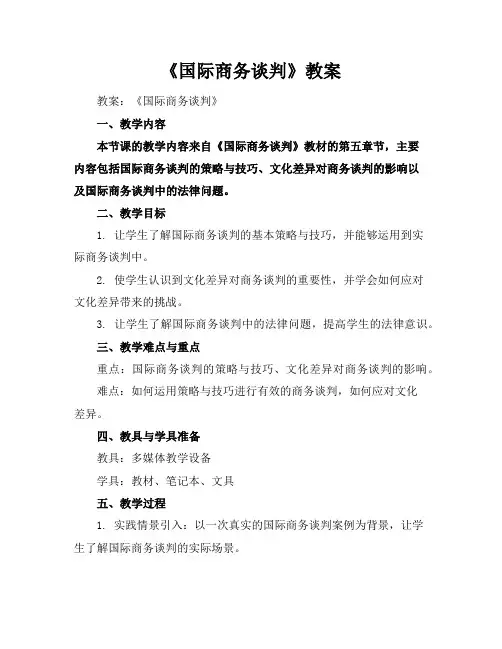
《国际商务谈判》教案教案:《国际商务谈判》一、教学内容本节课的教学内容来自《国际商务谈判》教材的第五章节,主要内容包括国际商务谈判的策略与技巧、文化差异对商务谈判的影响以及国际商务谈判中的法律问题。
二、教学目标1. 让学生了解国际商务谈判的基本策略与技巧,并能够运用到实际商务谈判中。
2. 使学生认识到文化差异对商务谈判的重要性,并学会如何应对文化差异带来的挑战。
3. 让学生了解国际商务谈判中的法律问题,提高学生的法律意识。
三、教学难点与重点重点:国际商务谈判的策略与技巧、文化差异对商务谈判的影响。
难点:如何运用策略与技巧进行有效的商务谈判,如何应对文化差异。
四、教具与学具准备教具:多媒体教学设备学具:教材、笔记本、文具五、教学过程1. 实践情景引入:以一次真实的国际商务谈判案例为背景,让学生了解国际商务谈判的实际场景。
2. 教材内容讲解:讲解第五章节的内容,包括国际商务谈判的策略与技巧、文化差异对商务谈判的影响以及国际商务谈判中的法律问题。
3. 例题讲解:通过具体的例题,让学生了解如何运用策略与技巧进行有效的商务谈判,如何应对文化差异。
4. 随堂练习:让学生分组进行模拟商务谈判,锻炼学生的实际操作能力。
5. 板书设计:板书重点内容,帮助学生记忆和理解。
6. 作业设计:布置相关的作业题目,巩固所学知识。
六、作业设计1. 请简述国际商务谈判的策略与技巧。
2. 请谈谈你对于文化差异对商务谈判的影响的理解。
3. 请列举出国际商务谈判中的法律问题,并简述其解决方法。
答案:1. 国际商务谈判的策略与技巧包括:了解对方的需求和底线,善于倾听和表达,灵活运用各种谈判手段,掌握时间节奏,善于打破僵局等。
2. 文化差异对商务谈判的影响主要表现在:沟通方式、商务礼仪、合同签订、谈判风格等方面。
3. 国际商务谈判中的法律问题包括:合同法律问题、知识产权法律问题、税收法律问题等。
解决方法包括:了解相关法律法规,寻求专业法律人士的帮助等。
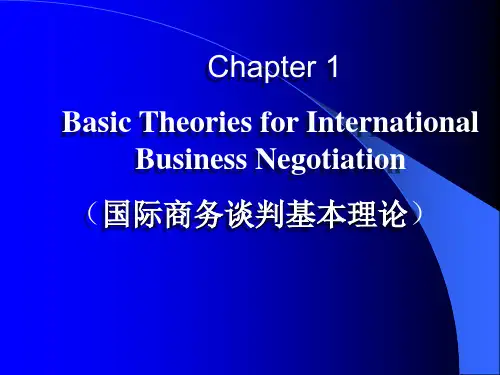

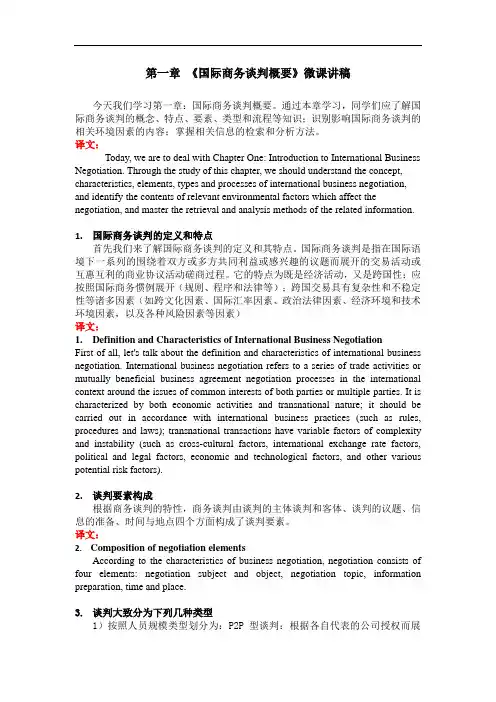
第一章《国际商务谈判概要》微课讲稿今天我们学习第一章:国际商务谈判概要。
通过本章学习,同学们应了解国际商务谈判的概念、特点、要素、类型和流程等知识;识别影响国际商务谈判的相关环境因素的内容;掌握相关信息的检索和分析方法。
译文:Today, we are to deal with Chapter One: Introduction to International Business Negotiation. Through the study of this chapter, we should understand the concept, characteristics, elements, types and processes of international business negotiation, and identify the contents of relevant environmental factors which affect the negotiation, and master the retrieval and analysis methods of the related information.1.国际商务谈判的定义和特点首先我们来了解国际商务谈判的定义和其特点。
国际商务谈判是指在国际语境下一系列的围绕着双方或多方共同利益或感兴趣的议题而展开的交易活动或互惠互利的商业协议活动磋商过程。
它的特点为既是经济活动,又是跨国性;应按照国际商务惯例展开(规则、程序和法律等);跨国交易具有复杂性和不稳定性等诸多因素(如跨文化因素、国际汇率因素、政治法律因素、经济环境和技术环境因素,以及各种风险因素等因素)译文:1.Definition and Characteristics of International Business NegotiationFirst of all, let's talk about the definition and characteristics of international business negotiation. International business negotiation refers to a series of trade activities or mutually beneficial business agreement negotiation processes in the international context around the issues of common interests of both parties or multiple parties. It is characterized by both economic activities and transnational nature; it should be carried out in accordance with international business practices (such as rules, procedures and laws); transnational transactions have variable factors of complexity and instability (such as cross-cultural factors, international exchange rate factors, political and legal factors, economic and technological factors, and other various potential risk factors).2.谈判要素构成根据商务谈判的特性,商务谈判由谈判的主体谈判和客体、谈判的议题、信息的准备、时间与地点四个方面构成了谈判要素。

国际商务谈判International Business NegotiationA negotiation is a meeting or a series of meetings in which the parties need each other ' s agreement to reach a specific objective.The fundamental principles of negotiation1. Negotiation is an element of human behavior.2. Negotiation takes place only over issues that are negotiable.3. Negotiation takes place only between people who have the same interest.4. Negotiation takes place only when negotiators are interested not only in taking but also in giving.5. Negotiation takes place only when negotiating parties trust each other to some extent.Chapter 1 Negotiation motives and key terminology 谈判动机与关键词语Negotiation 谈判Conflicts 冲突Stakes利益Case study: Matsushita Electric Corporation 松下电器公司NEGOTIATION 谈判A successful negotiation must satisfy at least the following conditions:1. The outcome of negotiation is a result of mutual giving and taking. One sided concession or compromise can not be called a successful negotiation.2. Negotiations happen due to the existence of conflicts, however, no negotiations can proceed smoothly and come to a satisfactory solution without collaboration between the participants.3. Negotiation is a behavioral process, not a game; in a good negotiation, everybody winssomething. Success isn ' t winning everything; it ' s winning enough.CONFLICTS 冲突The definition of conflicts states three points:1. Parties in conflicts are interdependent, which means there remains a kind of relationship developed by interrelated interests and concerns. There would be no conflict if two parties were not interrelated and had nothing to do with each other.2. Con tradictio ns and in terests coexist. If there are on ly con tradictio ns and no shari ngof com mon in terests, n egotiati ons become groun dless and unn ecessary.3. Two parties in a conflict will naturally fight for each other ' s own interests and nevery effort to gain more from the other side, as a result it will reduce gain of interestsexpected in itially.STAKES利益Stakes are the value of ben efits that may be gained or lost, and costs that may bein curred or avoided. Four points n eed to be clarified:1. Negotiation parties will either gain the interests they expect to win from then egotiati on or lose what they hope to attai n, which in dicates that the talks are pert inent to releva nt parties ' own affairs and in terests. Only whe n a party has stakes conn ected with the issues to be talked, can it become actively engaged in the negotiation.2. Free lunch is not provided at the n egotiati on table, in ano ther word, to get what is desired, both parties have to pay for the gaining at either high cost or low cost depe nding on how well n egotiators man age the situati on.3. The n egotiators will have to decide how much of stakes can be gained and whether a particular gain is the one that a party desires for. They will also have to decide how much they may gain if they choose opti on A in stead of opti on B.4. Negotiators will have to compare and bala nee the relati on betwee n the curre nt in terests and long term in terests or un derly ing desires in order to make decisi on on satisfy ing long term interests at the cost of current interests.Effective negotiati ng (VCD)成功谈判Who s who in Effective NegotiationThe compa niesLevien SA , based in Brussels, Belgium.It is an intern ati onal compa ny which manu factures specialist paints and dyes.In its head office it has a small IT function which the company has decided to outsource.Okus IT, based in Swindon, in the South of En gla nd.They specialize in managing IT projects and taking over the IT departments of theirclie nt compa ni es.The n egotiati onOkus have sent a detailed writte n proposal to Levie n.The meet ing has bee n arran ged to n egotiate the terms of any agreeme nt.In particular the following two issues are likely to be sticking points:1. StaffingLevien would like to protect the jobs of their current IT team.They want Okus to employ the four members of the team, and are under pressure from the unions to make sure outsourcing contracts like this do not lead to redundancies.Okus, on the other hand, will not want totake on Levien ' s whole team.They already have project engineers based in Swindon.2. PricingOkus have proposed two levels of IT support: Level AA fixed monthly price which will cover all support work (daily maintenance and customer support) and specified project work (hardware and software upgrades, training. Etc.) Level BA lower monthly invoice based on just support work. Any additional project work will be logged and then added to the invoice the following month.1. Preparing the groundThe peopleAndrew Carter is Export Sales Manager for Okus IT. He has made the initial contact with Levien. He has met one of the Levien team, Sean, before.Karen Black is a Project Manager at Okus IT. She has prepared the specifications for this contract. This is the first time she has been involved in negotiating an overseas outsourcing contract. She is anxious about the meeting.Francoise Quantin is the current IT Manger at Levien. She is about to be promoted to Head of Logistics. She is keen that her IT team are protected.Sean Morrissey is from Levien ' s main subsidiary in Chicago. He has been sent to the Brussels Office to develop Levien ' s procurement policy.The negotiationAs the VCD begins, Andrew and Karen have arrived at Levien 'osffices and are waiting to meet Francoise and Sean.Script 1Karen Black and Andre Carter fail to communicate before they meet the Levin team.A =Andrew K =Karen F =Fran?oise S =SeanA: You sure you don ' t want one, Karen?K: Not for me.A: Of course, I don ' t know Francoise at all, but you ___ 'wviethgSoetyou about negotiating with him in Dallas two years ago, didn ' t I?K: I ' m sure you did, An drew. Can we just focus on the final package? We mustn . ' t They' re going to __ , but we ___ .A: That' s right. Sean was Head of Procurement at TEC in Atlanta.K: What we must keep in mind is _____ if they push us on staff cuts.A: Oh, we don ' t need to worry about that, Karen. We ________ . Se^hjjulsow are you?S: Good to see you aga in, An drew. Atla nta, was n ' t it?A: Dallas, actually.S: Right, three years ago.A: Two.S: Yeah, sure. You two know each other, right?F: You must be Karen Black. I ' m Francoise Quantin. Welcome to Lebvien.K: we ve spoken on the phone, haven ' t we? This is Andrew Carter, ourA: Sorry, I thought you two already knew each other.S: Well, ____ . Can we …?F: Before we start, would you like a coffee?K: That would be ni ce.F: Milk?K: Yes, please.Script 2Kare n Black and Andre Carter are better prepared for their meeti ng with the Lev in team.A: There you go.K: tha nks.A: So, we ' ll wait fdJielm to respond to our proposal.K: Yes, we know that the staff cuts and the price are __ ut we ' d better .A: And you ' d still like me to do the presentation?K: That ' s what hesad-h un ted you for, An drew.A: And you ' ll watch for their react ions and …K: And deal with any questio ns. Yes.A: Be careful with Sea n, Karen. He drives a hard barga in.K: I ' m sure I can handle him. Wen for a long day, aren ' t we?A: Well, you did pack a toothbrush, didn ' t you?F: Sorry to have kept you waiting. You must be Karen Black. I ' m Francoise Quantin and this is Sea n Morrissey.S: Good to meet you, Karen. Fran coise, this is my old sparri ng part ner, An drew Carter.F: Nice to meet you, An drew. How was your flight?K: Excelle nt. Less tha n an hour.A: Hardly time for the breakfast ___ .F: What about a coffee the n, before we start?S: Yeah, you can ___ .F: There ' s no need to hurry. Karen.S: An drew, you ' ll have ano ther one?A: Please. Milk, three sugars.F: Sit down, please.A: Are you ___ , Sean?S: Yeah, I ' m misshiengkitds and my wife. Andre and I _ in Dallas two years ago.A: Yes, __ ---thirty-six hours, wasn ' t it?S: Andrew, if a job ' s worth_d_o_i_n_g.,F: Perhaps we had better start now.。
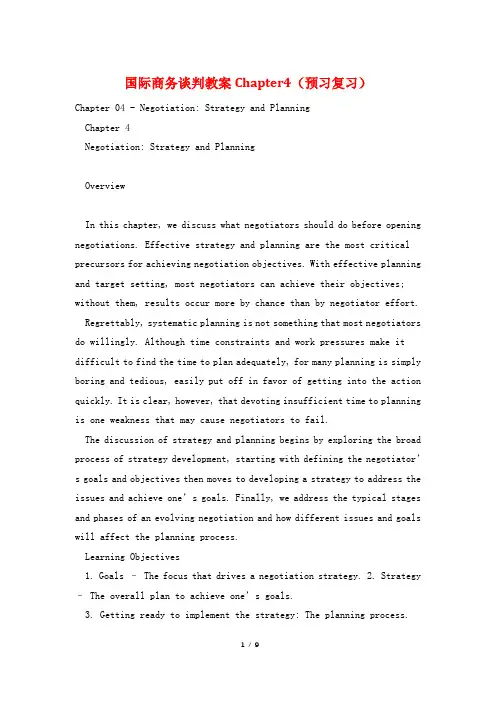
国际商务谈判教案Chapter4(预习复习)Chapter 04 - Negotiation: Strategy and PlanningChapter 4Negotiation: Strategy and PlanningOverviewIn this chapter, we discuss what negotiators should do before opening negotiations. Effective strategy and planning are the most critical precursors for achieving negotiation objectives. With effective planning and target setting, most negotiators can achieve their objectives; without them, results occur more by chance than by negotiator effort. Regrettably, systematic planning is not something that most negotiatorsdo willingly. Although time constraints and work pressures make it difficult to find the time to plan adequately, for many planning is simply boring and tedious, easily put off in favor of getting into the action quickly. It is clear, however, that devoting insufficient time to planningis one weakness that may cause negotiators to fail.The discussion of strategy and planning begins by exploring the broad process of strategy development, starting with defining the negotiator’s goals and objectives then moves to developing a strategy to address the issues and achieve one’s goals. Finally, we address the typical stages and phases of an evolving negotiation and how different issues and goals will affect the planning process.Learning Objectives1. Goals – The focus that drives a negotiation strategy.2. Strategy– The overall plan to achieve one’s goals.3. Getting ready to implement the strategy: The planning process.I. Goals – The Focus That Drives a Negotiation StrategyA. Direct effects of goals on choice of strategy1. There are four important aspects to understand about how goals affect negotiations: a. Wishes are not goals, especially in negotiation. b. Goals are often linked to the other party’s goals. c. There are boundaries or limits to what goals can be.d. Effective goals must be concrete, specific and measurable. If they are not, then itwill be hard to:(1) Communicate to the other party what we want (2) Understand what the other party wants(3) Determine whether an offer on the table satisfies our goals.2. Goals can be tangible or procedural.4-1Chapter 04 - Negotiation: Strategy and Planning3. The criteria used to determine goals depend on your specific objectives and your priorities among multiple objectives.B. Indirect effects of goals on choice of strategy1. Short-term thinking affects our choice of strategy; in developing and framing our goals, we may ignore the present or future relationship with the other party in a concern for achieving a substantive outcome only.2. Negotiation goals that are complex or difficult to define may requirea substantial change in the other party’s attitude. In most cases, progress will be madeincrementally, and may depend on establishing a relationship with the other party.II. Strategy – The Overall Plan to Achieve One’s GoalsA. Strategy versus Tactics1. A major difference between strategy and tactics is that of scale, perspective or immediacy.2. Tactics are short-term, adaptive moves designed to enact or pursue broad strategies, which in turn provide stability, continuity, and direction for tactical behaviors.3. Tactics are subordinate to strategy: they are structured, directed, and driven by strategic considerations.B. Unilateral versus bilateral approaches to strategy1. A unilateral choice is made without the active involvement of the other party.2. Unilaterally pursued strategies can be wholly one-sided and intentionally ignorant of any information about the other negotiator.3. Unilateral strategies should evolve into ones that fully consider the impact of the other’s strategy on one’s own.C. The dual concerns model as a vehicle for describing negotiation strategies. This model proposes that individuals have two levels of related concerns: a concern for their own outcomes, and a level of concern for the other’s outcomes.1. Alternative situational strategiesa. There are at least four different types of strategies when assessing the relativeimportance and priority of the negotiator’s substantive outcome versus the relational outcome: competitive, collaboration, accommodation, and avoidance2. The nonengagement strategy: Avoidancea. There are many reasons why negotiators may choose not to negotiate:(1) If one is able to meet one’s needs without negotiating at all, it may make sense to use an avoidance strategy(2) It simply may not be worth the time and effort to negotiate (although there are sometimes reasons to negotiate in such situations4-2Chapter 04 - Negotiation: Strategy and Planning(3) The decision to negotiate is closely related to the desirability of availablealternatives – the outcomes that can be achieved if negotiations don’t work out3. Active-engagement strategies: Competition, collaboration, and accommodation a. Competition is distributive win-lose bargaining. b. Collaboration is integrative or win-win negotiation.c. Accommodation is as much a win-lose strategy as competition, although it has adecidedly different image it involves an imbalance of outcomes, but in the opposite direction. (“I lose, you win” as opposed to “I win, you lose.”) d. There are drawbacks to these strategies if applied blindly, thoughtlessly orinflexibly:(1) Distributive strategies tend to create “we-they” or “superiority-inferiority” patterns, which may result in a distortion of the other side’s contributions, as well as their values, needs and positions.(2) If a negotiator pursues an integrative strategy without regard to the other’s strategy, then the other may manipulate and exploit the collaborator and take advantage of the good faith and goodwill being demonstrated.(3) Accommodative strategies may generate a pattern of constantly giving in to keep the other happy or to avoid a fight.III. Understanding the Flow of Negotiations: Stages and PhasesA. Phase models of negotiation:1. Initiation2. Problem solving3. ResolutionB. Greenhalgh (2001) suggests that there are seven key steps to an ideal negotiation process:1. Preparation: deciding what is important, defining goals, thinking ahead how to work together with the other party.2. Relationship building: getting to know the other party, understanding how you and the other are similar and different, and building commitment toward achieving a mutually beneficial set of outcomes.3. Information gathering: learning what you need to know about the issues, about the other party and their needs, about the feasibility of possible settlements, and about what might happen if you fail to reach agreement with the other side.4. Information using: at this stage, negotiators assemble the case they want to make for their preferred outcomes and settlement, one that will maximize the negotiator’s own needs.5. Bidding: the process of making moves from one’s initial, ideal position to the actual outcome.6. Closing the deal: the objective here is to build commitment to the agreement achieved in the previous phase.7. Implementing the agreement: determining who needs to do what once hands are shaken and the documents signed.4-3Chapter 04 - Negotiation: Strategy and PlanningIV. Getting Ready to Implement the Strategy: The Planning Process A. Defining the issues1. Usually begins with an analysis of what is to be discussed in the negotiation.2. The number of issues in a negotiation, along with the relationship between thenegotiator and the other party, are often the primary determinant of whether one uses a distributive or integrative strategy.3. In any negotiation, a complete list of the issues at stake is best derived from the following sources:a. An analysis of all the possible issues that need to be decided.b. Previous experience in similar negotiations.c. Research conducted to gather information.d. Consultation with experts in that industry.B. Assembling the issues and defining the bargaining mix1. The combination of lists from each side in a negotiation determines the bargaining mix.2. There are two steps a negotiator can use to prioritize the issues on an agenda: a. Determine which issues are most important and which are less important. b. Determine whether the issues are linked together or are separate.C. Defining Interests1. Interests may be:a. Substantive, that is, directly related to the focal issues under negotiation.b. Process-based, that is, related to how the negotiators behave as they negotiate.c. Relationship-based, that is, tied to the current or desired future relationshipbetween the parties.2. Interests may also be based on intangibles of negotiation.D. Knowing limits and alternatives1. Good preparation requires that you establish two clear points:a. Resistance point – the place where you decide that you should absolutely stop thenegotiation rather than continue.b. Alternatives – other agreements negotiators could achieve and still meet theirneeds. Alternatives define whether the current outcome is better than another possibility.E. Setting targets and openings1. Two key points should be defined in this step:a. The specific target point where one realistically expects to achieve a settlement4-4Chapter 04 - Negotiation: Strategy and Planningb. The asking price, representing the best deal one can hope to achieve.2. Target setting requires positive thinking about one’s own objectives.3. Target setting often requires considering how to package several issues and objectives.4. Target setting requires an understanding of trade-offs and throwaways.F. Assessing constituents and the social context of a negotiation1. When people negotiate in a professional context, there may be more than two parties. a. There may be more than two negotiators at the table. Multiple parties often leadto the formation of coalitions.b. Negotiators also have constituents who will evaluate and critique them.c. Negotiation occurs in a context of rules – a social system of laws, customs,common business practices, cultural norms, and politicalcross-pressures.2. “Field analysis” can be used to assess all the key parties in a negotiation. a. Who is, or should be, on the team on my side of the field?b. Who is on the other side of the field?c. Who is on the sidelines and can affect the play of the game? Who are thenegotiation equivalents of owners, managers and strategists?d. Who is in the stands? Who is watching the game, is interested in it, but can onlyindirectly affect what happens?e. What is going on in the broader environment in which the negotiation takesplace?f. What is common and acceptable practice in the ethical system in which the deal isbeing done?g. What is common and acceptable practice given the culture in which thenegotiation is conducted?G. Analyzing the other party1. Learning the other’s issues, preferences, priorities, interests, alternatives and constraints is almost as important as determining one’s own.2. Several key pieces of background information will be of great importance, including: a. The other party’s resources, issues, and bargaining mix – investigate:(1) Other party’s business history or previous negotiations. (2) Financial data. (3) Inventories.(4) Visit or speak with the other party’s friends and peers. (5) Question past business partners. b. The other party’s interests and needs.(1) Conduct a preliminary interview including a broad discussion of what the other party would like to achieve in the upcoming negotiations. (2) Anticipating the other party’s interests.(3) Asking others who know or have negotiated with the other party. (4) Reading how the other party portrays him/herself in the media.4-5。
Chapter 8 Law o f Trust 信任法则I.How to decide a person trusts and is trusted? 如何决定信任与被信任II.Determinations affecting a person’s trustful or mistrustful behavior 决定信任与非信任的因素III.Effects of trust信任的效应munication Skills交际练习In a negotiation, trust between group leader and group members as well as trust between two negotiating parties is a decisive element of shaping relationship of all sides.trust leads to poor relationship and thus low degree of cooperation, on the other hand, trust leads to good relationship and high degree of cooperation.When people trust one another, relationship and are enhanced and when they each other, relationship and cooperation suffer.To enhance mutual trust and set up good relationship, negotiators should understand the meaning and pervasive effects of .Many people say trust means belief, , reliability, a good of a person, or a feeling of affection.These explanations are quite different.American professor Dale E. Zand elaborates the meaning of trust in his publication of Trust and Decision Process and points out:Trust consists of:1.Increasing your vulnerability2.To another person whose behavior is not under your control;3.In a situation in which the penalty, loss or deprivation you would suffer if theother person abuses or fails to protect your vulnerability;4.Is substantially greater than the benefit, reward or satisfaction you wouldgain if the other person fulfills or protects your vulnerability.The following simple example explains the meaning of the definition.Parents show trust when they hire a baby-sitter to take care of their baby so they do not have to their job or they may home to pay a visit to a friend or go for an entertainment.Leaving their baby to someone they do not know very well or have no affection to their vulnerability significantly because they cannot the baby-sitter’s behavior after leaving home.If the baby-sitter their vulnerability and hijack the baby, the tragedy will surely adversely the rest of their lives.But if the baby-sitter their vulnerability and take good care of the baby, then the parents can keep their mind on their work or enjoy their meeting with their friend or a party.There are three fundamental elements: information, influence and control.A person shows trust when he reveals he need not disclose.He increases his by telling others his goals, purpose, plans, alternatives or his problems.Others may make use of the information to impede or undermine his efforts.For example,A designer struck on a brilliant idea which he told a colleague working in the same office. The colleague used the idea to advance his own interests and was promoted soon.So a person who does not others will conceal or distort relevant information.He will facts, his purpose and his feelings.A person show trust when he shows others to his decisions since he increases his by asking for others’ advice which may deliberately him.For example,As a China’s famous story of Fighting in Chibi in Tale of Three States depicts Caocao (premier of East Han Dynasty) asked for Pangtong’s (a counselor secretly working for Dongwu, Caocao’s enemy) advice for defeating Dongwu. Pangtong offered him a seemingly clever advice, which turned out to be a part of fatal plot inducing him and his troops into a trap.Therefore, a person who shows will resist others’influence, deny and reject their suggestions and advice.A person shows when he delegates and permits others to act on their own on his behalf.By this way he increases his because he has to rely on others to make a judgment and to implement his plan and others may serious errors, ____ implementation and his plan.So if a person does not trust, he will try to impose over others and ____ his dependence on others.For example,The principal of a middle school had peep holes installed in all the doors of classrooms in order for the administrative to have a tighter over students.However the device produced skeptical atmosphere among staff members as wellbecause anyone teaching or staying in the classroom feels he is being watched over and he is not .In negotiation or in people’s daily life, elements affecting a person’s trustful or mistrustful behavior come form main sources: which is inalterable and grown-up experiences, which are changeable.Childhood educationStudies on childhood education on trust began in the 1950s, with the publication of Erik Erikon’s Childhood and Society. Since then many developmental psychologists have viewed trust and; mistrust as the cornerstones of human development.A child’s understanding of trust is from his own and the environment he is up.When a child’s desires and reliability are fulfilled in most cases, he tends to conclude that people are , otherwise, he may draw the from his unfulfillment that people are trustful.A child will tend to trust others if he is brought up in a simple, warm and _____ environment, and he is told the stories of help and trust.However in other context, a child’s parents and other people intentionally inform him of examples of mistrust to drive the that “Y ou can’t trust people”.Understandably, such child inclines not to others when he grows up.Professional or special trainingA person’s professional or special training can incline him a different orientation to .For instance, accountants and financial workers are oriented to be of financial statements full of identical numbers and how much they may differ from the real data.People working in human resources department appear to more the accuracy of a person’s description of his educational and working background, and it is an important reason that the application documents should be, at the request, _____by official certificates.Past credit recordA person’s willingness to trust another person on his knowledge of the other’s past record.We will not rust someone who to perform his duty or is to complete a task or fails to keep his .The reason for the failure may differ from time to time, however, if there isrepeated record of the person’s failure, is the natural results.Surely, a person can do better to improve his record and thus win others’trust.Competence of others to perform a taskA person’s willingness to trust another person depends on his estimation of the other’s ability to complete a task .At this point, there should be a distinction between capability and affection.For instance, you will not trust a teenager to send a large sum of money to a far away place although you him very much.When is confused with capability in one’s trust decision, more often than ____his plan will be undermined.Intentions of othersOur willingness to trust another person is determined by our interpretation of the other’s intentions. i.e. We will not trust those we believe who have intention, and who will exploit our resources and take of our trust to advance his own interests.We will not trust such kind of person even though he is and he has a good _____record.People’s interpretation of others’intentions and motives can be different from time to time depending on their understanding of others.Reward systemIn win-lose reward system, when competition is rewarded, i.e., our gain is the other’s loss and our loss is the other’s gain, trust the other is clearly not in our self-interest.Companies selling the same products are rivals in business and understandably they will conceal or information, withhold facts and their ideas.Things will be different in joint reward system in which is encouraged because in such reward system things won’t be done without joint efforts, so it is all natural that the two sides will each other, information, each other’s advice and reach common conclusion.Of course, in today’s world there are neither competitors nor cooperators. Where will things be directed depends on our efforts. It is hoped that trustful relationship among people should be on account of positive effects of trust.Trust is a decisive element in people’s relationship. We need trust between peers, superiors and , between producers and , teachers and .Studies show that trust intellectual development and originality, and leadsto emotional stability and self-control.Trust acceptance and openness of expression.Trust cooperation and mutual understanding, and it is fundamental for establishing sound relationship among negotiating team as well as between negotiating .People working in a team high in trust signal of trust to each other and _____trust form each other, which will increase level of trust among the members. Negotiations based on high level of trust can increase of double win results.Conversely, mistrust rejection and defensiveness, collaboration and relationship of team members and negotiating parties.The striking contrast of trust and mistrust between negotiating parties tells us that it is worthwhile we take great pains to find out ways to mutual trust.Some tentative suggestions are made here for consideration:1.Encourage mutual trust by establishing trust-rewarded system in_____education, in training and in .2.Buildup people’s confidence in trust bit by bit through giving ,influence, self-control and concessions, and seek reciprocation from theother.3.Discuss frankly with the other party what is generating innegotiation.4.Be sincere and honest to your negotiating team members andyour .1. What comment would you make in the following situations?1)Y ou’ve just heard news of a train crash.2)One of your colleagues is always chatting to everybody.3)One of your colleagues regularly works a twelve-hour day.4)Y ou’ve just had a very good meal.5)One of your colleagues keeps himself to himself.6)Y ou’ve just seen an exhibition you expected to be good; in fact it was not.7) A person you’ve just met says he is a film director.8)One of your colleagues looks very smart today.2. Answer the following questions1)How many means are needed for the sellers to inform the buyers of the quality? What are they?2)When selling some mechanical and electrical products, what means are generally used to express their quality?3)When negotiating on the packing, what aspect should the buyers pay attention to besides the right type of packing?4)When goods are sold on a CIF basis, who is under obligation to present a marine insurance policy or an insurance certificate at the time of negotiation, the seller or the buyer?5)Which method is safer and better for the seller, D/P or D/A?6)Why is commodity inspection indispensable in international trade?7)What’s the first step in a successful sales negotiation?8)Is it necessary for the seller to make an equal concession when the buyer grants him or her a concession?9)At the beginning of the negotiation, should the sellers open high or modest?10)When you meet with negotiators who harshly bargain with you, will you cancel the negotiation or continue?11) If a negotiator s ays: “I don’t have the authority to grant you that concession”, does it really mean that he or she hasn’t such authority or is it only negotiating tactics?5. Translate the following situational dialogue into English(交货Delivery)贺先生,我很高兴我们就价格和付款方式问题达成了协议。